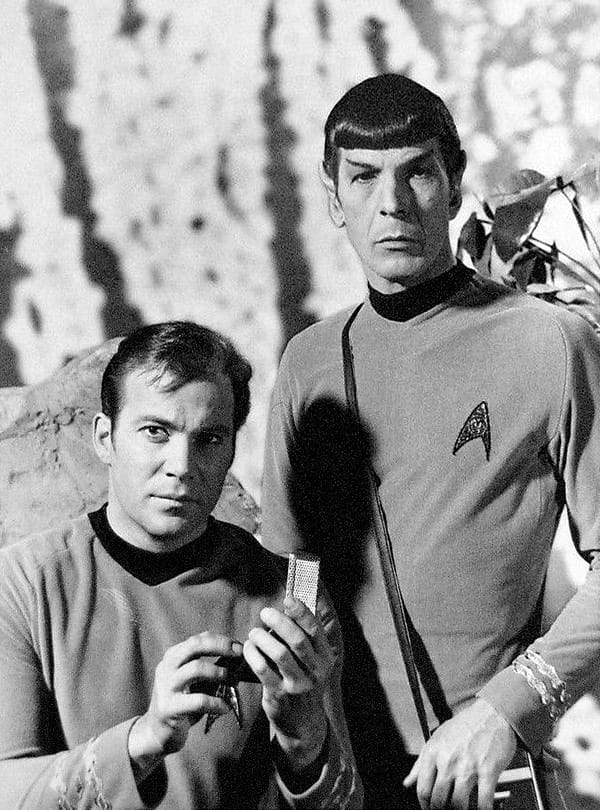beam me up, Scotty

Beam me up, Scotty! is a slang catchphrase inspired by the original Star Trek television series (1966–69). It used as a jocular expression of a desire to be somewhere other than the present place or situation. To beam is a verb used in the series to describe the process of the starship Enterprise’s transporter, and Scotty is the ship’s chief engineer who often operated the transporter. But like many such immortalized “quotations,” it was never actually uttered on the series, although in a few instances it came close to being said. (Cf. my work here is done)
The use of to beam to denote the action of such a transporter predates Star Trek. It appears in Samuel A. Peebles, et al. 1951 A Dictionary of Science Fiction:
MATTER TRANSPORTER—In SF, an apparatus which dissembles [sic] an object, transmits it through space and re-assembles it at another point. The transported matter is usually broken into its component atoms, keyed, “beamed” and reconstructed by a specially keyed receiver. Travel is thus instantaneous.
(The dictionary cites two sources that allegedly use beam in this sense, but neither one actually does. Beam is used to refer to a beam of light in one and to a directed-energy weapon in the other. So this dictionary is the earliest use found so far.)
In a Star Trek context, beam appears in the 1964 story outline creator Gene Roddenberry used to pitch the show to the networks, where it appears as an adjective:
The cruiser itself stays in space orbit, rarely lands upon a planet. Recon parties (small groups, featuring continuing characters) are set down via an energy-matter scrambler which can “materialize” them onto the planet’s surface. This requires maximum beam power and is a tremendous drain on the cruiser’s power supply. It can be done only across relatively short line-of-sight distances.
The verb appears in the 29 June 1964 first draft of the script of The Cage, which would become the pilot for the series:
The landing party is beamed to materialize on arid, rocky Sirius IV a quarter mile from the wrecked ship.
In the 1968 book The Making of Star Trek, Roddenberry is recorded as commenting:
If someone had said, “We will give you the budget to land the ship,” our stories would have started slow, much too slow. The fact that we didn’t have the budget forced us into conceiving the transporter device—“beam” them down to the planet—which allowed us to be well into the story by script page two.
As for the phrase appearing on the show, Captain Kirk uttered, “Beam us up” at the end of the episode The Gamesters of Triskelion, and he put Scotty at the head of the phrase in The Savage Curtain when he said, “Scotty, beam us up fast.” But the exact phrase, “Beam me up, Scotty” was never uttered on the show.
As for slang use of the phrase, it seems to have been in place by the late 1970s. Linguist Connie Eble’s Campus Slang of 4 April 1978 has this entry:
all right, Spock, beam us up! — exclamation of a need to get out of a party or any uncomfortable situation
Eble’s record has Spock rather than Scotty. While Spock rarely operated the transporter, he was often at the receiving end of communications requesting a beam up, so it’s certainly possible that early uses of the slang phrase had considerable variation before settling on a canonical form.
We finally see a published use of beam me up, Scotty the Oxford English Dictionary has a quotation from the 31 July 1984 issue of American Banker, of all places, a publication that indicates the slang phrase had become widespread by this date:
“Beam me up Scotty, there's no prospect of finance down here.” Undoubtedly, that's what Star Trek's Captain Kirk, commander of the science-fiction Starship Enterprise, would say if he came here in search of bank loans to fund extraterrestrial activities.
And the following month on 23 August 1984, we get a Usenet post by someone with the moniker Lt. Suvok, the name of a character in Star Trek fan fiction:
Beam me up,Scotty,it's millertime!!
and
Beam me up,Scotty,I'm getting some strange looks here!!
(The lack of spaces after the commas is in the original post.)
The phrase is now often seen in an extended form: Beam me up Scotty, there’s no intelligent life down here, which could be an apt description of the internet.
Sources:
Green’s Dictionary of Slang, n.d., s.v. beam me up, Scotty!, excl.
Historical Dictionary of Science Fiction, 2021, s.v. beam, v.
Lt. Suvak. “STIV In Search Of...Dr. Who,” Usenet: net.startrek, 23 August 1984.
Oxford English Dictionary, Additions Series, 1993, s.v. beam, v.
Peeples, Samuel A., David A. Kyle, and Martin Greenberg. “A Dictionary of Science Fiction.” In Travelers in Space. Martin Greenberg, ed. New York: Gnome Press, 1951, s.v. matter transporter, 24. Archive.org.
Roddenberry, Gene. “’The Cage’: Pilot Story Outline” (first draft, 29 June 1964). In Stephen E. Whitfield and Gene Roddenberry. The Making of Star Trek. New York: Ballantine, 1968, 48. Archive.org.
Roddenberry, Gene. “Star Trek” (story outline, 1964). In Stephen E. Whitfield and Gene Roddenberry. The Making of Star Trek. New York: Ballantine, 1968, 26. Archive.org.
Roddenberry, Gene, Arther Heinemann, and Arthur H. Singer (writers). “The Savage Curtain.” Star Trek, Herschel Daugherty (director), airdate: 7 March 1969.
Roddenberry, Gene and Margaret Armen (writers). “The Gamesters of Triskelion,” Star Trek, Gene Nelson (director), airdate: 5 January 1968.
Whitfield, Stephen E. and Gene Roddenberry. The Making of Star Trek. New York: Ballantine, 1968, 43–44. Archive.org.
Photo credit: NBC Television, c. 1966. Wikimedia Commons. Public domain image.